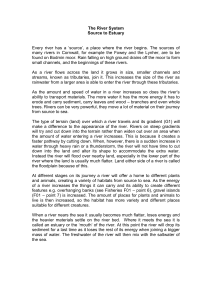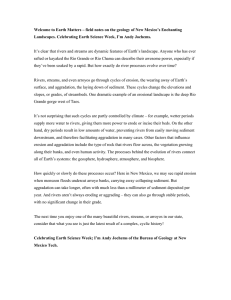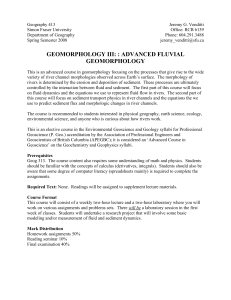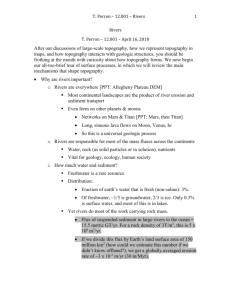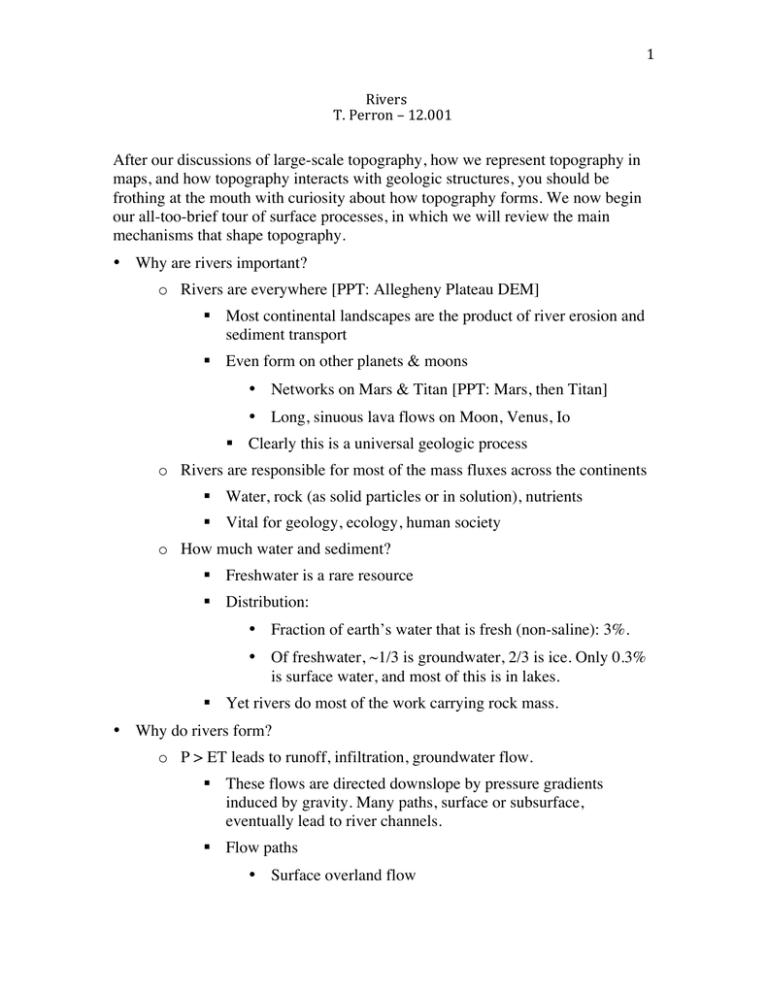
1 Rivers T. Perron – 12.001
After our discussions of large-scale topography, how we represent topography in
maps, and how topography interacts with geologic structures, you should be
frothing at the mouth with curiosity about how topography forms. We now begin
our all-too-brief tour of surface processes, in which we will review the main
mechanisms that shape topography.
• Why are rivers important?
o Rivers are everywhere [PPT: Allegheny Plateau DEM]
§ Most continental landscapes are the product of river erosion and
sediment transport
§ Even form on other planets & moons
• Networks on Mars & Titan [PPT: Mars, then Titan]
• Long, sinuous lava flows on Moon, Venus, Io
§ Clearly this is a universal geologic process
o Rivers are responsible for most of the mass fluxes across the continents
§ Water, rock (as solid particles or in solution), nutrients
§ Vital for geology, ecology, human society
o How much water and sediment?
§ Freshwater is a rare resource
§ Distribution:
• Fraction of earth’s water that is fresh (non-saline): 3%.
• Of freshwater, ~1/3 is groundwater, 2/3 is ice. Only 0.3%
is surface water, and most of this is in lakes.
§ Yet rivers do most of the work carrying rock mass.
• Why do rivers form?
o P > ET leads to runoff, infiltration, groundwater flow.
§ These flows are directed downslope by pressure gradients
induced by gravity. Many paths, surface or subsurface,
eventually lead to river channels.
§ Flow paths
• Surface overland flow
T. Perron – 12.001 – Rivers 2 • Shallow subsurface flow and return flow
• Deep groundwater flow, including flow up to stream
channels
§ Hydrographs
• Precip, stream discharge, groundwater discharge
• Streamflow response to a precip event depends on
drainage basin size & runoff characteristics
• Effects of urbanization
• What determines the size of a river channel (which in turn
determines how much flow it can convey before it spills
over its banks)? Small, frequent flows, or large, rare
flows?
• Your lab explores flood frequency analysis, which is one
way to answer this question empirically: what is the
recurrence interval of a flow that just fills the banks?
Note that Precip is really recharge (=P-ET), and units are volume/area/time
o Formation of channels, valleys and networks [PPT: Gabilan]
§ If erosion rate depends on flux of water, land surface is unstable
with respect to water erosion à channelization [PPT]
§ The positive feedback makes rivers cut valleys, and the rest of
the landscape slopes toward them
T. Perron – 12.001 – Rivers 3 § Other processes prevent channels from forming everywhere
• Thresholds: Finite strength of land surface and river banks
due to cohesive sediment, ice, vegetation roots, etc.
• Smoothing by mass movement of soil/sediment
o Soil creep
o Small landslides
o Rain splash
§ The larger the spatial scale, the more dominant the positive
feedback is à river networks [PPT: Model, then Allegheny]
• How do rivers evolve over time? Erosion and deposition: processes that control
changes in river bed elevation depend on whether bed is exposed bedrock, or
always covered by sediment
o Flow in rivers is driven by downslope component of weight of water,
and is balanced by resistance associated with shear stress on the bed
o Exposed BR: what controls the rate at which rivers erode rock?
§ Plucking: water removes pieces of the bed. Rate depends on flow
stress (and therefore velocity), rock strength. But this is thought
to be slower than erosion by sediment
§ Impact wear by saltating (rolling, hopping) grains
o Sediment cover: What controls the rate of aggradation or degradation of
an “alluvial” bed, with no exposed bedrock?
§ Conservation of mass (aka the Exner equation) for bed sediment
with a volume fraction η:
w
ΔV wΔxΔz 1
=
= (Qs,in − Qs,out ) = ( qs,in − qs,out )
Δt
Δt
η
η
1 ( qs,out − qs,in )
Δz
=−
Δt
η
Δx
1 ∂qs
∂z
=−
∂t
η ∂x
T. Perron – 12.001 – Rivers (In 2D, for conservation of a quantity φ, you will often see
4 ∂φ
+ ∇ ⋅φ = 0 )
∂t
§ In general, sediment flux scales with (a power of) bed shear
stress. Relationships determined from field monitoring,
experiments
• How do rivers change along their path from headwaters to ocean? [PPT:
Brahmaputra]
o If you walked down a river starting from a topographic divide, what
changes in channel geometry, sediment and processes would you see?
[Sketch concave-up long profile]
§ Slopes become gentler, until eventually reaching base level (can
be sea level, an inland water body, or even a dry basin)
§ No channel à channel
§ Less exposed bedrock
§ Fining sediment (boulders à gravel à sand à silt)
o Why does sediment get (exponentially) finer downstream?
§ Abrasion breaks down grains, so the farther they travel, the
smaller they get
§ Selective transport: as slope, and therefore stress, decrease
downstream, the maximum transportable grain size shrinks
• Planform morphology of alluvial rivers [PPT: meandering vs. braided]
o Rivers that have little or no exposed bedrock shape their own geometry
through erosion & sediment deposition
o Why do some rivers meander?
§ Flow-steering instability
• Perturbation in flow path or bed topography steers flow to
one side
• Superelevation of water surface along outer part of bend
alters pattern of shear stress
• Stress decreases downstream on inside of bend à point
bar deposition; stress increases downstream on outside of
bend à bed and bank erosion. Requires stabilization of
point bar by vegetation, cohesive sediment, ice, etc.
• The river bend becomes more curved, which creates a
stronger superelevation à positive feedback
T. Perron – 12.001 – Rivers 5 • Meander bends grow until cut off during floods [PPT:
Birch Creek, Alaska]
© source unknown. All rights reserved. This content is excluded from our Creative
Commons license. For more information, see http://ocw.mit.edu/help/faq-fair-use/.
o Why do others braid? [PPT: Waimakariri]
§ Easily eroded bank material (little or no cohesion)
§ Channel widens during high flow, and medial bars are deposited
as flow recedes and sediment transport capacity declines
§ Why don’t braided streams widen indefinitely? Eventually flow
depth gets so small that stress is insufficient to transport
sediment, especially at banks.
§ Illustration of importance of bank cohesion: [PPT: Tal movie].
Diminished occurrence of braided channels in the rock record
may be a signature of the rise of life on the continents.
• Depositional systems: What happens when a river meets a body of water?
o Deltas [PPT: Lena, Nile, Eberswalde Delta, Mars]
§ Slopes decline to zero, so there’s a downstream decrease in shear
stress à deposition
§ River can build outward along the same path, but this leads to a
further decrease in slope
§ Eventually the difference in slope is large enough that river
changes course during a flood: avulsion.
§ Over time, occupation of, and deposition along, many different
flow paths builds a fan-shaped delta
T. Perron – 12.001 – Rivers 6 MIT OpenCourseWare
http://ocw.mit.edu
12.001 Introduction to Geology
Fall 2013
For information about citing these materials or our Terms of Use, visit: http://ocw.mit.edu/terms.

